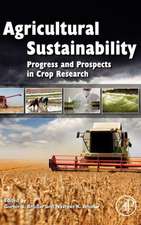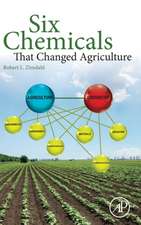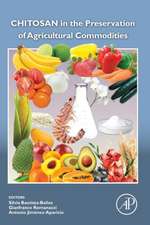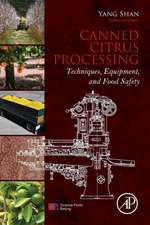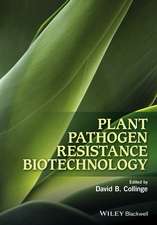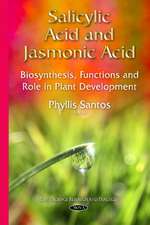Insect Resistance Management: Biology, Economics, and Prediction
Editat de David W. Onstaden Limba Engleză Hardback – 4 dec 2007
* First book in 15 years to provide the history and explore aspects of a variety of stakeholders* Contributors include experts on ecological aspects of IRM, molecular and population genetics, economics, and IRM social issues* Biochemistry and molecular genetics of insecticides presented with an mphasis on past 15 years of research including Cry proteins in transgenic crops* Encourages scientists and stakeholders to implement and coordinate strategies based on local social conditions
| Toate formatele și edițiile | Preț | Express |
|---|---|---|
| Hardback (2) | 420.95 lei 5-7 săpt. | |
| ELSEVIER SCIENCE – 4 dec 2007 | 0.00 lei Indisponibil | |
| ELSEVIER SCIENCE – 22 oct 2013 | 420.95 lei 5-7 săpt. |
Preț: 385.69 lei
Preț vechi: 500.89 lei
-23% Nou
Puncte Express: 579
Preț estimativ în valută:
73.81€ • 80.15$ • 62.00£
73.81€ • 80.15$ • 62.00£
Carte tipărită la comandă
Preluare comenzi: 021 569.72.76
Specificații
ISBN-13: 9780123738585
ISBN-10: 012373858X
Pagini: 320
Dimensiuni: 152 x 229 x 23 mm
Greutate: 0.59 kg
Editura: ELSEVIER SCIENCE
ISBN-10: 012373858X
Pagini: 320
Dimensiuni: 152 x 229 x 23 mm
Greutate: 0.59 kg
Editura: ELSEVIER SCIENCE
Public țintă
Pest control, crop science, agricultural economics researchers and scientists; entomologists; agricultural engineers; plant scientists; graduate-level studentsCuprins
Chapter 1
Major Issues in Insect Resistance Management
Chapter 2
Valuing Pest Susceptibility to Control
Chapter 3
Insecticide Resistance in the Post-Genomics Era
Chapter 4
Complexities of Population Genetics
Chapter 5
Adapting Insect Resistance Management Programs to Local Needs
Chapter 6
Negative Cross-Resistance: Past, Present, and Future Potential
Chapter 7
Resistance by Ectoparasites
Chapter 8
Insect Resistance to Crop Rotation
Chapter 9
Arthropod Resistance to Crops
Chapter 10
The Role of the Environment in IRM for Transgenic Insecticidal Crops
Chapter 11
Insect Resistance Management: Adoption and Compliance
Chapter 12
Modeling for Prediction and Risk Assessment
Chapter 13
Monitoring Resistance
Chapter 14
The Future of Insect Resistance Management
Major Issues in Insect Resistance Management
Chapter 2
Valuing Pest Susceptibility to Control
Chapter 3
Insecticide Resistance in the Post-Genomics Era
Chapter 4
Complexities of Population Genetics
Chapter 5
Adapting Insect Resistance Management Programs to Local Needs
Chapter 6
Negative Cross-Resistance: Past, Present, and Future Potential
Chapter 7
Resistance by Ectoparasites
Chapter 8
Insect Resistance to Crop Rotation
Chapter 9
Arthropod Resistance to Crops
Chapter 10
The Role of the Environment in IRM for Transgenic Insecticidal Crops
Chapter 11
Insect Resistance Management: Adoption and Compliance
Chapter 12
Modeling for Prediction and Risk Assessment
Chapter 13
Monitoring Resistance
Chapter 14
The Future of Insect Resistance Management
Recenzii
"...good editing has ensured a consistent writing style and prevented excess repetition. Also, the cross-referencing between the chapters helps tie them together. Nevertheless, the chapters stand very well on their own…a very readable prose." --Bulletin of the ESC
"This updated edition…is an excellent overview of IRM; hopefully, future researchers will work closely with plant pathologists, plant breeders, and even medical scientists struggling with very similar issues plaguing society that appear to stem from very similar biological processes. Summing Up: Highly recommended." --CHOICE, July 2014
"…recent advances in this dynamic field are well documented and explained in the second edition of the book…easy to read and the language is very accessible to non-specialists, so it should be considered a very valuable reference for students and professional researchers interested in IRM, including insect pathologists involved in the use of entomopathogens for pest control." --Society for Invertebrate Pathology Newsletter, June 2014
"Contributors from entomology, agriculture, and economics explore aspects of managing insect resistance to pesticides, reporting their own results, reviewing those of others, and offering practical suggestions for applying them. Among the topics are understanding resistance and induced responses of insects to xenobiotics and insecticides in the age of "omics" and systems biology, concepts and complexities of population genetics,…" --ProtoView.com, February 2014
"This updated edition…is an excellent overview of IRM; hopefully, future researchers will work closely with plant pathologists, plant breeders, and even medical scientists struggling with very similar issues plaguing society that appear to stem from very similar biological processes. Summing Up: Highly recommended." --CHOICE, July 2014
"…recent advances in this dynamic field are well documented and explained in the second edition of the book…easy to read and the language is very accessible to non-specialists, so it should be considered a very valuable reference for students and professional researchers interested in IRM, including insect pathologists involved in the use of entomopathogens for pest control." --Society for Invertebrate Pathology Newsletter, June 2014
"Contributors from entomology, agriculture, and economics explore aspects of managing insect resistance to pesticides, reporting their own results, reviewing those of others, and offering practical suggestions for applying them. Among the topics are understanding resistance and induced responses of insects to xenobiotics and insecticides in the age of "omics" and systems biology, concepts and complexities of population genetics,…" --ProtoView.com, February 2014

